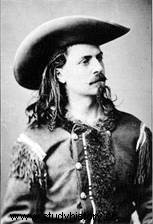 First scout in the United States Army, bison and Indian hunter, William Cody aka Buffalo Bill, becomes famous thanks to his adventures told in the newspapers. Understanding that he could benefit from it, he became a friend of the Redskins while accepting that a collection of booklets be published, “the only original edition authorized by Col. W.F. Cody , says Buffalo Bill”, published worldwide in several languages. Filmed in 1894, then in 1902, this mythical figure of the conquest of the west published his memoirs under the title "My life" and became the hero of several westerns. In order to distinguish between reality and legend, William Cody collaborated on serious works, countersigned by Colonel Henry Inman.
First scout in the United States Army, bison and Indian hunter, William Cody aka Buffalo Bill, becomes famous thanks to his adventures told in the newspapers. Understanding that he could benefit from it, he became a friend of the Redskins while accepting that a collection of booklets be published, “the only original edition authorized by Col. W.F. Cody , says Buffalo Bill”, published worldwide in several languages. Filmed in 1894, then in 1902, this mythical figure of the conquest of the west published his memoirs under the title "My life" and became the hero of several westerns. In order to distinguish between reality and legend, William Cody collaborated on serious works, countersigned by Colonel Henry Inman.
Origins of William Cody, aka Buffalo Bill
His real name, William Frederick Cody was born on February 26, 1846 in Iowa and lived in a pioneer hut. His family settled in Kansas a little later and the young William quickly became an excellent horseman.
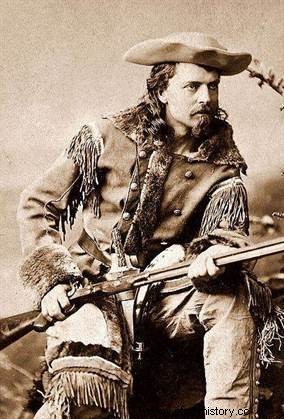 Early on, he was a "pony express rider" or postal courier, a very dangerous job; then he leads convoys across the plains and hunts buffalo for a living; scout and guide of the 5th Cavalry Regiment, he supplies meat to the workers during the construction of a railway line; having become head of the scouts of the corps responsible for watching over the construction work of the Union Pacific, he met the Redskins many times; at the command post of the scouts of the United States army, he also rubs shoulders with the great generals.
Early on, he was a "pony express rider" or postal courier, a very dangerous job; then he leads convoys across the plains and hunts buffalo for a living; scout and guide of the 5th Cavalry Regiment, he supplies meat to the workers during the construction of a railway line; having become head of the scouts of the corps responsible for watching over the construction work of the Union Pacific, he met the Redskins many times; at the command post of the scouts of the United States army, he also rubs shoulders with the great generals.
Considered an "expert at all shots", he never misses his mark when shooting colts, shotguns, rifles, etc. whether on animals, birds or enemies; "upright man, modest, simple, authoritarian but good, he avoids quarrels and never will, has excellent eyesight, knows how to appreciate distances, robust, tireless, always ready the first" according to the words of General Carr .
During the Civil War, he participated in the fighting, but he was also entrusted with intelligence missions before September 1865; scout, he transmits the mail of General Sheridan, in regions infested with Indians; in 1867, he accompanied General Custer; during the construction of the Kansas Pacific Railroad line in the same year, he slaughtered 3,000 bison and buffalo (to feed the workers) and earned his nickname Buffalo Bill.
In the book "Thirty Years Among the Indians" by Colonel Richard Irwing Dodge, we discover that "the famous scout enjoys deserved popularity...We know Bill Cody, having campaigned with him three times against the Indians...we can testify that Buffalo Bill is also adored by the army and the men of the frontier, that he is dreaded by the plumed Indians of whom he is the terror ".
At the end of 1872, he received the Congressional Medal of Honor (which he had to return in 1916, not being part of the army, the rank being purely honorary) then is a member of the Nebraska legislative body, but he left the post for the East Coast. He participated in a fortnight of combat against the Indians, exercising the function of independent mercenary, with horses provided by the army, as well as maintenance, food, lodging and obtaining additional bonuses for dangerous missions. His good reputation has earned him fame and he serves as a guide for famous visitors such as the Grand Duke Alexis (3rd son of Tsar Alexander II of Russia). He finds that he can increase his income.
Buffalo Bill and the Wild West Show
He was only 26 years old when he decided to change his life and give up his missions to perform. Developing the myth born around him, he will create a gigantic show retracing the major stages of the Conquest of the American West. However, when there was a conflict in 1876 with the Sioux, he was present and joined the 5th Cavalry Regiment.
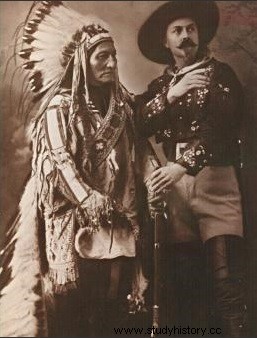 In 1872, he attended a theatrical performance "Buffalo Bill, King of Western Men". He is the star in a play presented in Chicago and then on the east coast. He creates a company made up of Indians and cowboys which will exist for ten years, to which is added Major John M. Burke. At the start, it is a small show with shooting exercises, cavalcades and Indian dances; then on the occasion of Independence Day on July 4 in 1882, he produced a larger show in Nebraska with shooting competitions, horse training (rewards in support...which attracts people), hunting bison…it's a huge success.
In 1872, he attended a theatrical performance "Buffalo Bill, King of Western Men". He is the star in a play presented in Chicago and then on the east coast. He creates a company made up of Indians and cowboys which will exist for ten years, to which is added Major John M. Burke. At the start, it is a small show with shooting exercises, cavalcades and Indian dances; then on the occasion of Independence Day on July 4 in 1882, he produced a larger show in Nebraska with shooting competitions, horse training (rewards in support...which attracts people), hunting bison…it's a huge success.
He then thinks of doing even bigger things by putting on the "Wild West Show" and his Redskins. For this, he chose his staff, sought out renowned shooters, performed in amusement parks and decided to make a tour of Europe in 1887-1888. On the occasion of the Universal Exhibition in 1889, Buffalo Bill set up his show for seven months in Paris; after a tour in France until March 1890, he goes to Belgium, England:he is so well received that he decides on a second tour in several cities between 1905 and 1906, it will be a huge success.
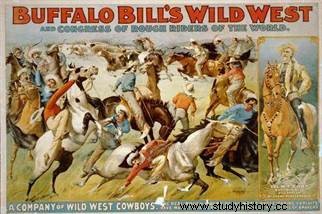 But between two performance tours, out of friendship for his Indians, William Cody left to defend them when the army decided to eliminate them in 1890… it arrives too late, the Indian chief Sitting Bull is killed on December 15. He can only save about twenty Indians formed in defense movement and brings them back with him in his show in Europe.
But between two performance tours, out of friendship for his Indians, William Cody left to defend them when the army decided to eliminate them in 1890… it arrives too late, the Indian chief Sitting Bull is killed on December 15. He can only save about twenty Indians formed in defense movement and brings them back with him in his show in Europe.
This tour would last four years between 1902 and 1906, being called the "Program". At Christmas 1902 he is in England; on April 2, 1905 he arrived in France and remained in Paris until June 4, then went on tour to 21 cities where he reached Nîmes and Avignon at the end of October 1905; at the end of November, he was in Marseilles, then went to Nice and Italy before leaving for America in November 1906.
Around 1909, Buffalo Bill merged with another group becoming "the Pawnee Bill West" but went bankrupt in 1913, because a serious competitor had existed since 1908 "the 101 Ranch Wild West Show in which Cody was invited to participate in 1916, the tour then taking the name of "Buffalo Bill and 101 Ranch Shows Combined".
But worn out by alcohol and disease, William Frederick Cody died on January 10, 1917 in Denver, Colorado:for 33 years he had been the main star of his show, presented in 2,000 cities, 12 countries and having received 50 million spectators.
The 1905 “Programme” and the tour of Europe
France welcomes with great enthusiasm the troop of Buffalo Bill in 1905 composed of outstanding horsemen and hundreds of warrior Indians, because curiously the Redskins are better accepted here than in Europe (London, the Vatican, Belgium). William Cody promotes these people and even if he frequently fought against them, he went to meet them when they were confined to their reservations in Pine Ridge or Cheyenne River asking them to participate in his show. He managed to hire prestigious Redskins and Sioux leaders, such as Sitting Bull on a salary of $50 a week. On the posters, under the portrait of the Indian, we find the following caption "Sitting Bull and Buffalo Bill, enemies in 1876, friends in 1885".
Why this friendship, when Buffalo Bill spent part of his life killing them? In his show, Wiliam Cody wanted to show two aspects of this people:the very wild side and their submission to the superior civilization. The children of the Redskins, recognizing themselves the superiority of the soldiers of the army, agree to follow the enemy of their fathers.
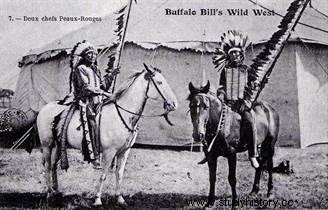 The Cowboy Orchestra opens the show presented by Buffalo Bill. The spectators discover great parades, exhibitions of Indian, Cossack and Mexican horsemen, a convoy of emigrants, shooting exercises, two great maneuvers carried out by veterans of the army and by the United States militia, exercises by the French, English, American cavalry, a stagecoach attack, several equestrian entertainments, General Custer's last stand, a horse race ridden by the Indians among the best known Iron Tail (Queue-de-Fer) which is already 75 years old in 1905 and Sam Lone Bear (Lone Bear) 28, finally the final parade led by Buffalo Bill.
The Cowboy Orchestra opens the show presented by Buffalo Bill. The spectators discover great parades, exhibitions of Indian, Cossack and Mexican horsemen, a convoy of emigrants, shooting exercises, two great maneuvers carried out by veterans of the army and by the United States militia, exercises by the French, English, American cavalry, a stagecoach attack, several equestrian entertainments, General Custer's last stand, a horse race ridden by the Indians among the best known Iron Tail (Queue-de-Fer) which is already 75 years old in 1905 and Sam Lone Bear (Lone Bear) 28, finally the final parade led by Buffalo Bill.
The logistics were impressive for the time:500 horses, 700 participants and technicians, 16 vessels to cross the ocean for 2 hours of grandiose spectacle where Buffalo Bill was considered the “collector of human races who allowed warriors of all nations to shake hands! .
He begins his tour in France, stopping in Normandy, Brittany, in the West, but one region is more privileged:the Camargue is very popular with Indians, horses , the bulls, the vast expanses, the feeling of freedom, the magic of the wild space resembling a lot the great plains and the activities of the American West.
There, in the South of France, the Marquis Folco de Baroncelli-Javon, aristocrat, poet, writer and owner of horses and bulls, welcomed them with passion in Nîmes in October 1905; he does them the honors of the region by showing them the work in the animals, the games with bulls and horses. Queue-de-Fer (Iron Tail) and Yeux-Blancs (Jacob White Eyes) are at first very surprised, not daring to move, then very impressed by the agility of the rider and his horse:a great and long friendship was born.
Franco-Amerindian friendship
When young, the Marquis de Baroncelli-Javon already consulted books on the American West and the Indians. Having become famous, he always wanted to save lost causes, by supporting in one way or another the peoples crushed by invaders from elsewhere. Wanting to preserve the identity of his region and its customs, to fight for its language, he recognizes that the fight of the Amerindians is the same:the history of their roots and the survival of an ideal. He dedicated a poem to them and paid homage to them in Provençal literature with his war song “La danse des Esprits” in honor of the leaders Queue-de-Fer and Ours Solitaire (Lone Bear) composed in 1905.
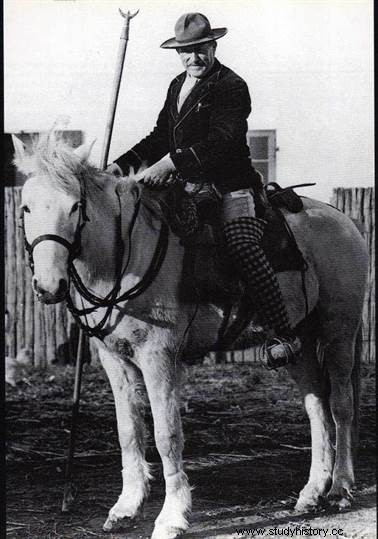 At the same time, a young French painter, Joë Hamman traveled to America, creating new friendships with this country. Returning to France, he met the Marquis de Baroncelli-Javon and both passionate about this people of Indians, sent their news, received those of their friends and decided to tell their story and their life by making films:the first westerns at the time of silent cinema were thus made in the Camargue.
At the same time, a young French painter, Joë Hamman traveled to America, creating new friendships with this country. Returning to France, he met the Marquis de Baroncelli-Javon and both passionate about this people of Indians, sent their news, received those of their friends and decided to tell their story and their life by making films:the first westerns at the time of silent cinema were thus made in the Camargue.
Friendship still exists between these two peoples:the Indians came to honor the Marquis de Baroncelli-Javon, "Buffalo Bill's friend of the Indians" on the anniversary of the 500 years of meeting of the two peoples, in June 1992. A beautiful friendship that continues!
Bibliography
- Buffalo Bill, biography of Michel Faucheux. Folio, Buffalo Bill, biography of Michel Faucheux. Folio, 2017.
- Buffalo Bill and the Wild West Show, by Jacques Portes. Editions du Chêne, 2016.
